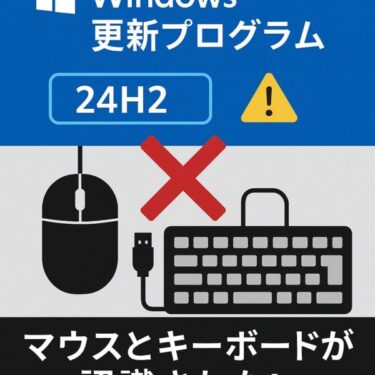After installing Windows 11 version 24H2, some users find their USB mouse or keyboard suddenly stops working—sometimes right at the sign-in screen. Don’t panic. The issue is usually a clash between new security/driver rules, BIOS/UEFI settings, and USB controllers, not a dead device. Work through the fixes below from quickest to most effective.
Why this happens on 24H2 (at a glance)
| Cause | What’s going on |
|---|---|
| USB/HID driver conflicts | 24H2 tightens driver security; outdated HID/USB drivers may not load. |
| Secure Boot / Memory Integrity (HVCI) | Kernel-mode drivers that aren’t compatible with Core isolation > Memory integrity get blocked. |
| BIOS/UEFI changes | Some systems revert or ship with USB legacy/CSM options disabled, so keyboards don’t work until Windows loads. |
| Bluetooth stack regressions | If you use a Bluetooth keyboard/mouse, 24H2 updates have caused reconnect/pairing issues on some hardware. |
| Fast Startup oddities | Hybrid shutdown can leave USB in a weird state on next boot. |
Microsoft continues to update the 24H2 Release Health page as issues are fixed—if a new known issue matches your device, install the servicing update that addresses it.
Quick wins (try these first)
1) Move the dongle/cable to another port (prefer a USB 2.0 port)
USB 2.0 ports often enumerate basic keyboards/mice more reliably—especially during early boot. Test rear-panel ports on desktops or the opposite side on laptops.
2) Power-cycle and disable Fast Startup once
- Fully shut down: Shift + Click “Shut down.”
- Boot, then go to Control Panel > Power Options > Choose what the power buttons do > uncheck Turn on fast startup > Save.
This clears strange USB states after major updates.
3) Plug in a basic wired USB keyboard/mouse
Wireless (esp. Bluetooth) devices may not work until Windows loads the stack; a cheap wired set gets you signed in so you can fix drivers/settings. Bluetooth instability after 24H2 has been reported on some models—use wired while you remediate.
If you can’t type at the sign-in screen
4) Enable Legacy USB support in BIOS/UEFI
Reboot, enter firmware setup (often F2/Del/F12), and enable options like Legacy USB Support / USB keyboard support. Save and reboot. This ensures input works before Windows loads.
5) Use the On-Screen Keyboard (touch devices)
At the sign-in screen, tap the Accessibility icon → On-Screen Keyboard to enter your PIN/password, then proceed with the driver fixes below.
Fix the root cause in Windows
6) Update or clean-reinstall HID/USB drivers
- Open Device Manager → expand Keyboards, Mice, and Universal Serial Bus controllers.
- Right-click any device with a warning → Update driver.
- If issues persist, remove the device (Uninstall device) and Scan for hardware changes, or reinstall the vendor driver package.
7) Check Core isolation > Memory integrity
Windows Security may be blocking an old kernel-mode driver your mouse/keyboard depends on.
- Go to Settings > Privacy & security > Windows Security > Device security > Core isolation.
- If you see “A driver can’t load on this device”, update/remove the incompatible driver from the vendor, then keep Memory integrity ON.
- For troubleshooting only, you can temporarily turn Memory integrity OFF, reboot, confirm input works, then update drivers and re-enable it. (Security trade-off—re-enable ASAP.)
8) Safe Mode check (isolates third-party conflicts)
Force three failed boots to enter Windows Recovery → Troubleshoot > Startup Settings > Restart → press 4 for Safe Mode.
If your input works in Safe Mode, a third-party service/driver is the culprit—update or uninstall it from Apps & features/Device Manager.
9) Bluetooth-only setups
If your keyboard/mouse is Bluetooth and not responding after 24H2:
- Remove and re-pair the device; install any OEM Bluetooth driver/firmware updates.
- Keep a wired fallback until Microsoft/OEM fixes for your model roll out via Windows Update.
Last resorts
10) Go back to the previous build (within ~10 days)
Settings > System > Recovery > Go back to restore the pre-24H2 state if nothing else works—then try the latest cumulative update that addresses your device’s issue.
11) Repair options
- System Restore to a point before the update.
- In-place repair install using the latest Windows 11 media (keeps apps/files) to refresh the driver stack.
At-a-glance cheat sheet
| Step | Priority | Why |
|---|---|---|
| Try another port (prefer USB 2.0) | High | Quickest way to re-enumerate input |
| Disable Fast Startup once | High | Clears hybrid-shutdown USB glitches |
| Use a wired keyboard/mouse | High | Bypasses Bluetooth timing issues |
| Enable Legacy USB in BIOS | High | Ensures pre-boot input works |
| Update/clean-reinstall HID/USB | Medium | Replaces blocked/old drivers |
| Check Memory integrity block | Medium | Unblocks driver loading (with caution) |
| Safe Mode isolation | Medium | Confirms third-party conflicts |
| Roll back / Repair install | Low | Use if all else fails |
Notes & housekeeping
- Keep Windows Update current—Microsoft has been resolving 24H2 device-compatibility issues over time.
- If your vendor (Lenovo/HP/Dell/ASUS, etc.) provides chipset/USB controller and Bluetooth updates for your exact model, install those first; many post-24H2 input issues get fixed at the OEM level.


